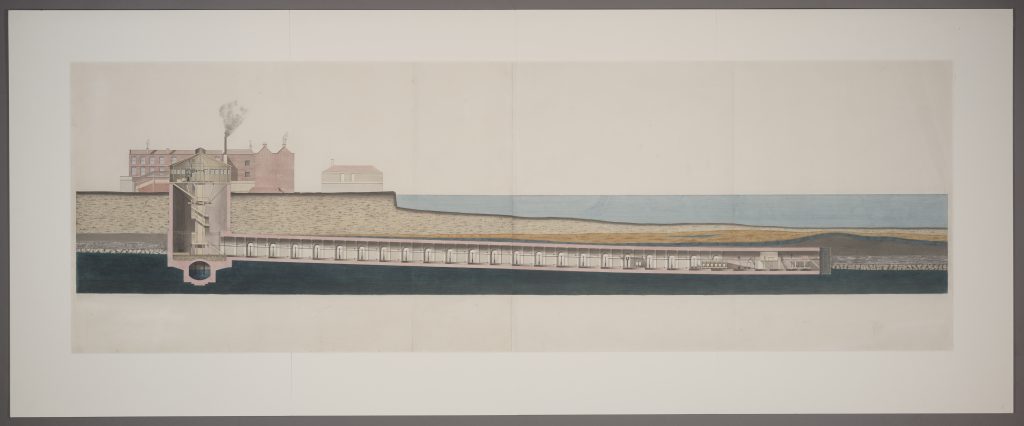This is a cross-sectional view of the Thames Tunnel mid-construction, believed to have been drawn by Brunel’s chief mechanical draftsman, Joseph Pinchback, during or shortly after 1831. By this point in the Tunnel’s history, progress had come to a complete standstill. A second flood and subsequent failure to secure additional funding had ended in the tunnel being bricked up in August of 1828. The watercolour presents an almost eerie depiction of the partially-completed Tunnel, devoid of life bar the smoke plumes in the background.
On the left hand side is the Rotherhithe shaft, sump, and nearby buildings. Throughout the Tunnel, trolleys and piles of brick serve as a reminder of the sudden halt in construction. The strata of earth to the right are drawn with an undulating layer of blue clay—which differs from the levelness of earlier drawings. Notably, no visual reference is made to the flooding.
The watercolour gives an interesting insight into the most turbulent years of the Tunnel’s history, and may have been used to portray the current state of the Tunnel while attempting to gain funding. In fact, in September 1831, a bill was passed to allow the Tunnel Company to borrow funds from the Exchequer Loan Commissioners, after a few turbulent years of petitioning, funding would be secured and work resumed in March 1835. Certainly, the careful rendering, lack of technical details, and appealing use of colours all point towards this image’s purpose as a ‘presentation piece’ shown to investors, government officials, and select members of the public. The lack of figures, a characteristic shared by some other watercolours held by the Museum (see LDBRU:2017.8), suggests that the primary focus was to portray the design—and therefore current progress—of the Tunnel, rather than to stir up interest from the wider public.
Technical drawings had become an integral part of engineering throughout the Industrial Revolution (circa 1750-1900). However, in the early 1800s, engineers including Marc Brunel began better to understand and appreciate them as a visual medium for shaping public perception and engaging public interest.
Their purpose can be gleaned from certain characteristics in their visual appearance. For example, those intended for the workplace were more likely to incorporate technical details, but pieces such as this one favoured a pictorialist use of colours and lighting. These traits created an appealing visual style, and were easily transferred to engraving and mass-dissemination via print.
Over time, technical drawings and illustrations began to play a more prominent role in early 19th century engineering, and draughtsmen like Pinchback soon solidified their specialist role in the industry distinct from architects, designers, and engineers. Brunel had various employees — both draughtsmen in official capacity and other positions — produce and modify the watercolours in this collection, and their impact to the eventual success of the tunnel should not be understated. In fact, at the same time Brunel was awarded a silver Telford medal in 1838 for his design and communication of the tunnelling shield, Pinchback was given a bronze medal recognising the “beauty of the drawings.”
If you’d like a print of the artwork displayed above, you can purchase one from the ArtUK online shop.

